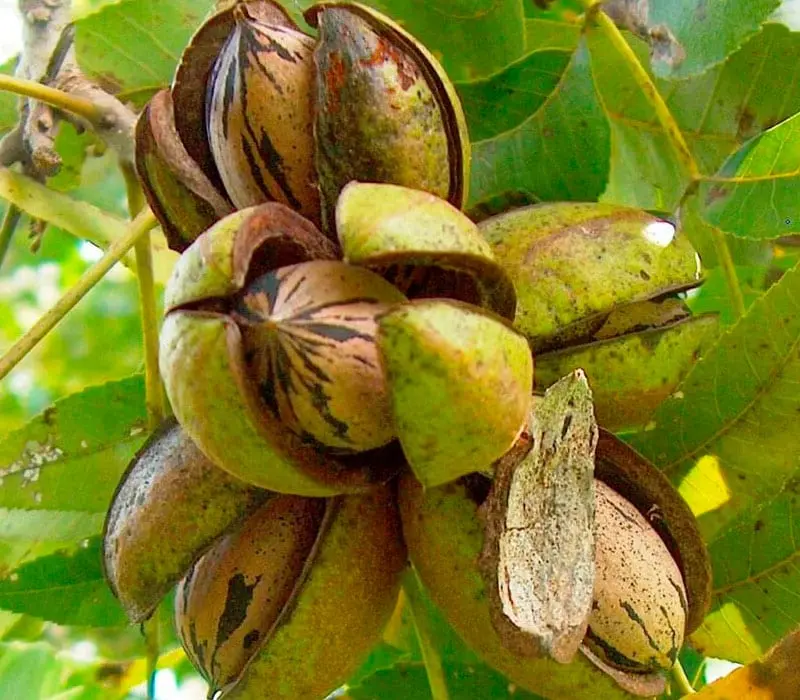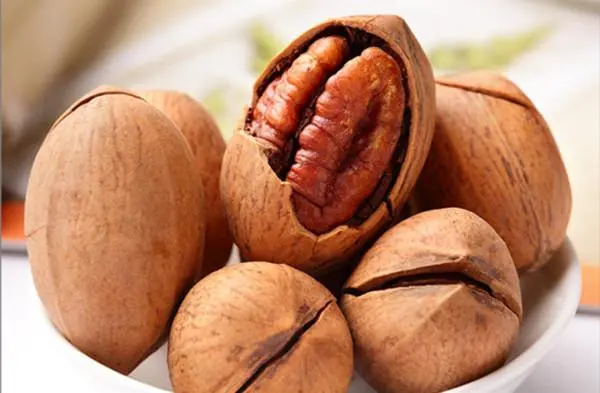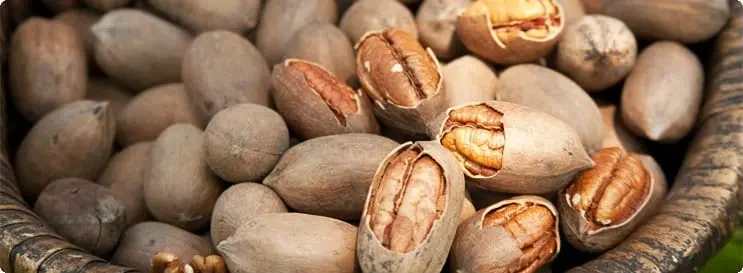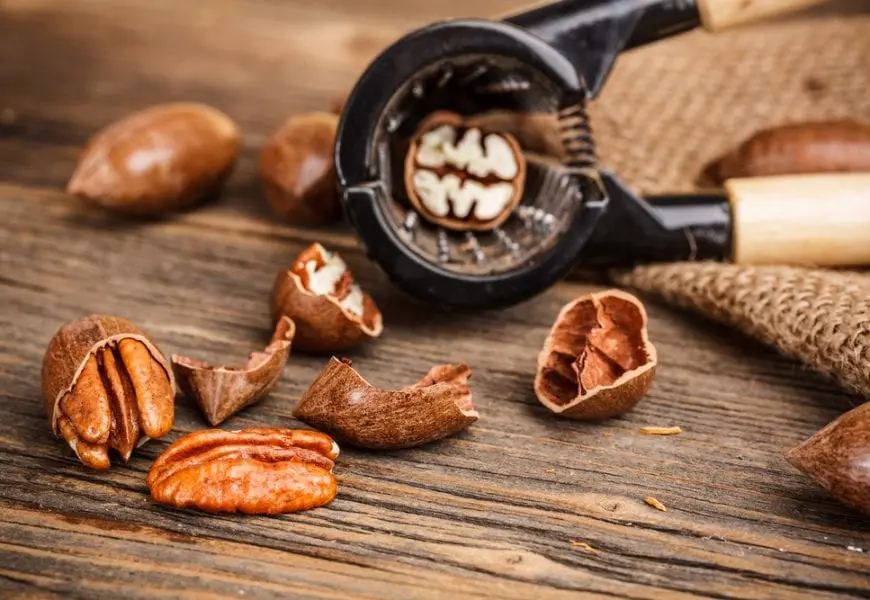Contents
Description
Pecan is one of the most hearty nuts, not only extremely nutritious, but also packed with vitamins and minerals.
The pecan nut looks very familiar on the outside as it resembles a walnut. However, the pecan has a more elongated shape, it is slightly larger in size, and the grooves on its surface are not so sinuous and deep. The pecan’s shell is smooth, and the nut itself, like a walnut, consists of two halves. It is well known that Pecans grow in Mexico, in the southern states of the USA and in Asian countries, that is, where the heat is.
Also pecans are considered very oily and contain 70% fat, so they spoil quickly and are best eaten as soon as possible. Secondly if you need to store a supply of pecans, do not keep the nuts warm, but place them in the freezer so they will not spoil and will retain vitamins.
Pecan history

Pecan grows on huge trees that can reach a height of forty meters. The trees are long-lived and can bear fruit for up to 300 years.
The native land of the plant is considered to be North America, where the wild nuts were originally collected by the Indians. They prepared them for future use in case of a hungry winter, because nuts were as nutritious as meat. Nowadays, many varieties of pecans are cultivated in the United States, and they are still the traditional favorite nut of Americans.
Outwardly, the nut is similar to the walnut, and is its relative. But the taste and aroma of pecan is much softer and brighter, and the absence of bitterness makes it an excellent addition to desserts.
Where and how do nuts grow?

Pecan, a native of North America, is today grown in Australia, Spain, Mexico, France, Turkey, Central Asia, and the Caucasus. In different countries, it was used in different ways, for example: in North America, nuts have become mandatory in the diet, both on ordinary days and on holidays.
In Mexico, nutritious, energetic milk is prepared from these nuts by grinding pecan kernels and mixing with water. Children and the elderly are fed with a delicate nut mass. It is believed that they help to survive in any conditions.
The pecan tree is a thermophilic plant. But the experiments of botanists have shown that the nut has successfully taken root in Ukraine, withstanding prolonged low temperatures in winter. Promising areas for cultivation are the south, west and southwest of the country.
There is a hope that the attractive rich composition and numerous useful properties of the pecan nut will become irreplaceable and invaluable in our nutrition and treatment.
Composition and calorie content

- Caloric content 691 kcal
- Proteins 9.17 g
- Fat 71.97 g
- Carbohydrates 4.26 g
Pecans and nuts are rich in vitamins and minerals such as: vitamin B1 – 44%, vitamin B5 – 17.3%, potassium – 16.4%, magnesium – 30.3%, phosphorus – 34.6%, iron – 14, 1%, manganese – 225%, copper – 120%, zinc – 37.8%
Pecan benefits
Pecans are extremely high in calories, because they are 70% fat. With insufficient nutrition, these nuts are indispensable, and a large handful of them can saturate and energize. Pecans are considered the most fatty of all nuts.
Pecan is rich in vitamins A, B, C, E, and also contains trace elements: iron, calcium, phosphorus, magnesium, potassium, zinc. Vitamins A and E are well absorbed from pecans as they are fat-soluble. They improve the condition of the skin, nails and hair.
Pecan contains exactly the kind of vitamin E, on the basis of which the drug was made that inhibits the growth of cancer cells. It is possible that regular consumption of pecans can reduce the risk of cancer.
Pecans, like other nuts, are high in polyunsaturated fatty acids (omega-3 and omega-6). Thanks to them, as well as dietary fiber, pecans provide a feeling of fullness for a long period of time.
Pecan harm

The main harm of pecan lies in its high calorie content. Even people without excess weight should not get carried away with this nut, since overeating can cause indigestion.
For obesity, liver problems, and a tendency to severe allergies, it is best not to eat pecans at all to avoid worsening the condition. Nuts are strong allergens, so nursing mothers and children under 3 years old need to exclude pecans from the diet.
The use of pecan in medicine
In modern medicine, pecans are not used, and even in folk medicine, the nut is little known. Tribes in North America sometimes brew tree leaves or extract oil from nuts, considering it medicinal.
Masks-scrubs are made on the basis of crushed pecans to nourish and cleanse the skin with soft nut particles. Pecan oil is added to various cosmetics to enhance their effect. In its pure form, the oil moisturizes the skin and helps fight stretch marks.
The use of pecans in cooking

Pecans are sometimes fried before use, but if the dish is baked, the nuts are used raw. Roasting enhances the unusual flavor of the nuts and reveals caramel notes.
Pecans are especially often used in America, adding it not only to baked goods, but even to soups and salads. On holidays, hostesses often bake pecan pies.
Pecan pie

This delicacy can be afforded only occasionally, since it is very high in calories. The honey in the filling can be replaced with maple syrup or even thick yogurt – but you have to adjust the sweetness by adding extra sugar. The cake is large, the amount of ingredients can be reduced if a smaller portion is required.
For the test
- Wheat flour – 2 cups
- Butter – 200 gr
- Egg – 1 piece
- Cream (from 33% fat) or fat sour cream – 4 tablespoons
- Brown sugar – 4 tablespoons
For filling
- Pecans – 120 g
- Large egg – 2 pieces
- Brown sugar – to taste
- Liquid honey or maple syrup – 250 gr
- Butter – 70 gr









